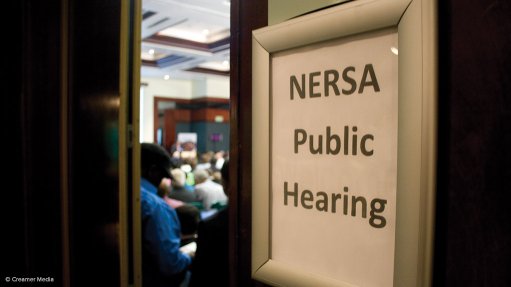
Photo by: Creamer Media
The affordability of the 32% tariff hike being sought by Eskom for implementation on April 1 next year came under intense scrutiny on the last day of National Energy Regulator of South Africa (Nersa) public hearings.
The regulator, which adjudicated the first year of the three-year fifth multiyear price determination (MYPD5) in January, when it approved a 9.61% increase for the 2023 financial year against an Eskom request for 20.5%, expects to decide for the 2024 and 2025 financial years by November 7.
The utility has applied for allowable revenue of R351-billion for 2024 and R382-billion for 2025, inclusive of the R15-billion a year arising from a court order stipulating that the utility be allowed to recover, over five financial years, the full R69-billion equity injection Nersa incorrectly deducted from its MYPD4 allowable revenue.
If granted, the standard Eskom tariff would rise to 172.6c/kWh on April 1, or by more than 32%.
Eskom argues that even after such a steep hike, the tariff would remain below a cost-reflective level, which it calculates to be 185.7c/kWh.
TERRIBLE INJUSTICE
The utility’s request was strongly opposed by all of the presenters on the third and final day of the hearings, including Cape Town Mayor Geordin Hill-Lewis, who urged Nersa to unequivocally reject the request and instead grant no increase above the current inflation rate.
Warning that South Africans were being confronted with a cost-of-living crisis, Hill-Lewis argued that it would be a “terrible injustice” to expect electricity consumers to pay for previous mismanagement and corruption at the utility, particularly in the context of intensifying load-shedding.
He noted, too, that all of the 70 bidders that responded to the city’s recent tender to procure an initial 200 MW of renewable electricity had been able to beat even Eskom’s lowest prevailing tariff.
City of Johannesburg MMC Michael Sun added that the proposed tariff hike would have a “devastating impact” on the citizens of Johannesburg, erode business confidence and disrupt economic recovery.
Sun added that City Power was of the view that Eskom could reduce its proposed revenue by R55-billion, for each of the years covered by the application, reducing the increase to a maximum of 18.4% for the 2024 financial year.
However, Mogale City mayor Tyron Gray also called for an inflation-linked increase, indicating that ongoing load-shedding was resulting in water disruptions in the high-lying Gauteng city and that a price hike would exacerbate the problem, owing to the nature of the water/power cross subsidies in place.
DISALLOW DIESEL REQUEST
Energy Intensive Users Group (EIUG) CEO Fanele Mondi warned that a 32% increase would have a significant negative impact on its mining and heavy-industrial members, given that electricity represented up to 40% of their costs.
Mondi made specific recommendations with regard to how Nersa should treat various cost components in Eskom’s application, including the utility request for R16.9-billion next year and R17.7-billion in the 2025 financial year to operate its diesel-fuelled power plants.
The increase outlined by Eskom is based on deploying the plants at a load factor of 12%, rather than 5%, to offset the fall in the coal and nuclear fleet’s energy availability factor to 59% from 62%.
“This represents a staggering R11.8-billion and R12.41-billion [additional cost for diesel] for the respective years,” he noted.
The EIUG requested Nersa to disallow the request for higher diesel volumes, which made up 60% of the increase, and instead base any increased allowance on real diesel price increases.
“Nersa should get a better explanation for the seemingly excessive volume increase.
“If it is due to poor generation performance, rather consider investing more money in maintenance and demand-side-management incentives.
“Such a reallocation will be a more sustainable investment financially with an opportunity to decrease the costs in the medium term,” Mondi argued.
PRICE-SETTING OVERHAUL
Well-known electricity analyst Clyde Mallinson proposed an overhaul to the entire process of determining electricity prices, arguing that Nersa is seeking to regulate what was the biggest disruption to the electricity supply industry in a century using a method that was “totally unfit for purpose”.
He warned of a price bifurcation, whereby South Africa was pursuing plans to provide competitive green hydrogen on the basis of highly competitive renewable electricity, while considering a “exorbitant” 32% hike for South African consumers.
“How can we justify exporting cheap green hydrogen to keep the Europeans warm in winter when we cannot supply cheap renewable energy to our own citizens,” Mallinson asked.
Eskom CFO Calib Cassim acknowledged the affordability concerns, but urged the regulator to assess its application on “its merits”, as was required in terms of the law and the MYPD methodology.
He argued that vulnerable consumers and industries should not be supported by subsidised tariffs, but rather through direct and targeted subsidies, which would cost the fiscus less than the “cost of subsidising the current annual shortfall between Eskom’s regulated revenue and its prudent and efficient costs”.
Cassim reiterated that Eskom’s financial sustainability required a full transition to a cost-reflective tariff and could not rely primarily on a solution from government to its unsustainable R440-billion debt profile.
“Hypothetically, debt relief of between R150- and R200-billion in the absence of cost-reflective revenue levels will buy Eskom a runway of about three to four years cash flow reprieve.”